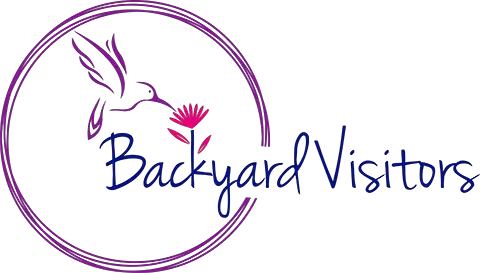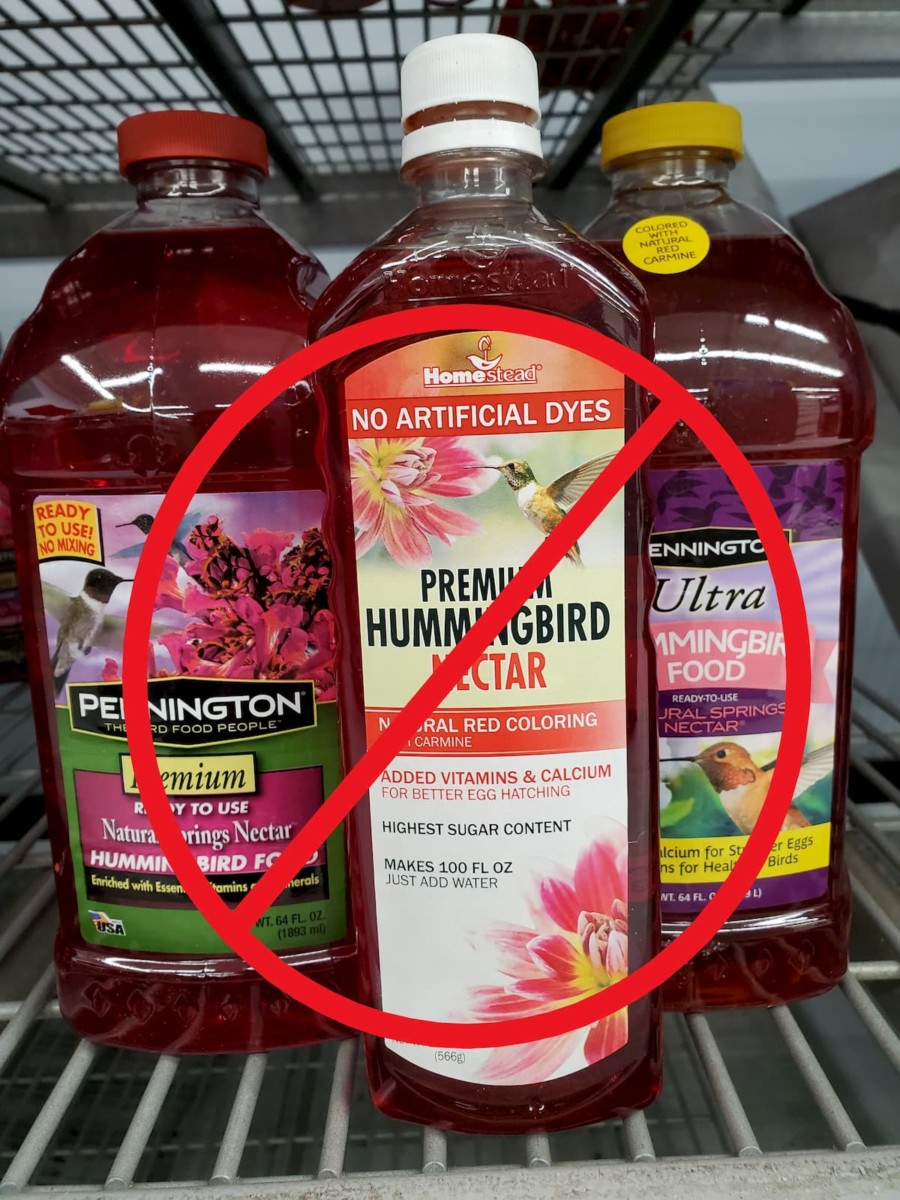This post contains affiliate links.
As I was walking through my local nursery I came upon a display of commercial pre-made hummingbird nectar. I began to wonder if homemade hummingbird nectar, like my mother would always prepare, is better for the hummingbirds than the commercial pre-made products found at the store.
Mothers are full of knowledge, experience, and observation. I would never doubt my mother’s expertise, but I wanted to be completely confident in this information for the future.
Is homemade hummingbird nectar better than commercial nectar?
Homemade hummingbird nectar made of sugar and water has more nutritional value than commercial nectar. Dissolving the correct 1 to 4 sugar to water ratio closely resembles the nectar located in hummingbird attracting flowers. Commercial hummingbird nectar contains red dyes and preservatives.
This question has been discussed and pondered frequently by many people. Everybody wants to keep their hummingbirds happy, healthy and safe. Choosing the correct ingredients for homemade hummingbird nectar is the first hurdle to cross and the most important first step to complete.
Even though scientific research has found side effects resulting in undesirable health issues when hummingbirds continually feed on colored artificial sugar water from the store; there is no conclusion that commercial nectar will harm hummingbirds.
Making your own homemade nectar is easier, more cost-effective and all-around safer for the hummingbird. Buying commercial nectar from the store costs approximately $15 for a 64 oz bottle, while the same quantity can be made at home for pennies.
Homemade hummingbird nectar has only two main ingredients, sugar and water. Finding the correct ratio will guarantee your homemade hummingbird nectar to succeed in attracting and aiding nourishment to our fine feathered friends.
What is the best homemade hummingbird nectar recipe?
The consensus for the best homemade hummingbird nectar recipe is 1 cup of granulated white sugar dissolved in 4 cups of spring or filtered water. To make a smaller batch of nectar, mix ¼ cup sugar to 1 cup of water. Two simple ingredients of sugar and water, when mixed correctly, best resemble the natural nectar found in flowers.
Plain white sugar, table sugar, granulated sugar, regular sugar, and regular cane sugar are all common names used for your simple everyday sugar. All of these have had the natural molasses removed. Most tap water is adequate to use but spring or filtered water is preferred when making your homemade hummingbird nectar.
Do NOT use honey, organic sugars or any artificial sweeteners. This will be detrimental to the hummingbird’s health.
Hummingbirds who ingest honey can produce Candidiasis a fungal tongue infection or Avian poxvirus which is tumor growths on their beaks making it difficult for the hummingbird to consume food.
There is a common misconception that the word “organic”, in contrast with the word sugar, is safe for animals. That is not the case for hummingbirds. Organic and raw sugars are similar to brown sugar providing high iron levels that are toxic to hummingbirds and can damage their livers.
It is strongly recommended not to add synthetic or natural red food dyes to your homemade hummingbird nectar. Natural nectar is not red. It is the shape and color of the flower that is catching a hummingbird’s attention and they are rewarded generously with sweet nectar. The red base of a hummingbird feeder is all the red required to help attract the hummingbirds. Therefore, adding red food dye to your hummingbird nectar is not essential.
See my article: The One Thing You Need to Eliminate From a Hummingbird’s Diet
Making your own hummingbird nectar has the advantages of knowing your nectar is pure and unadulterated.
Homemade Hummingbird Nectar Recipe Directions
- Bring 1 part sugar and 4 parts water to a boil over medium/high heat on the stove stirring occasionally or microwave the mixture in a Pyrex measuring glass. Make sure to not let the sugar mixture burn because it will affect the flavor of the nectar.
- Once the sugar is dissolved (1-2 min), set the solution aside allowing for it to completely cool.
- If using the microwave method, heat the mixture every 30 seconds and stir until the sugar is dissolved.
- If you make the solution into a more concentrated form you may add ice cubes to cool down the mixture whether using the microwave or stovetop method.
- Make sure the nectar syrup is at room temperature or cool to the touch before pouring it into your preferred feeder. Hot nectar can burn the precious tongue of the hummingbirds and can damage your glass or plastic feeder causing leaks.
What is the shelf life of homemade hummingbird nectar?
Unused homemade hummingbird nectar can be stored in the refrigerator for 10 to 14 days. It is preferable to make a one-week supply of food at a time to keep the nectar fresh, consistent and free of bacteria for the hummingbirds. Warm nectar will ferment more quickly once it becomes contaminated.
This customary habit of making new hummingbird nectar every 5 to 7 days keeps the feeder clean of mold and mildew that may form inside or around the feeder when the summer days become extremely hot. Personally, I have no problem refilling my feeder regularly which will ensure frequent, healthy and happier visitors to my sanctuary.
What happens if I make my hummingbird nectar too sweet?
Nectar that is too sweet, for example, 1:2 sugar water ratio will attract unwanted visitors such as bees, wasps and bright yellow Orioles. Overly sweet nectar can promote fermentation and create a place for bacterial growth. The sticky sugary nectar can also make it difficult for the hummingbirds to digest.
Homemade hummingbird nectar that is too sweet can cause an imbalance in their overall health and impact their daily living which in turn presents obstacles hindering their ability to function properly. It can also attract unwanted guests and creates an annoyance for hummingbirds who are waiting patiently to feed.
A ratio greater than the recommended 1 part sugar to 4 parts water can result in large swarms of bees and wasps congregating near or around your hummingbird feeder.
When this occurs, you will find a disturbed and frustrated hummingbird who will feel the effects of these unwanted guests similar to an annoying fly constantly landing on your arm or nose while you are outside having a lovely summer lunch. Just as the irritation is enough to disrupt let alone discourage you from enjoying the outdoors, the hummingbird will also think twice about coming back to your feeder.
If a bee problem persists try decreasing the ratio to 1 part sugar to 5 parts water.
Bees will also remain or linger around your feeder during the hot summer months in search of water. Providing a bee-friendly watering station will decrease or eliminate bees coming to your hummingbird feeder for water.
See my article: Bees On My Hummingbird Feeder: (9 Tips To Get Rid of Them)
Bright yellow Oriole birds have been located hanging on outdoor hummingbird feeders when homemade nectar is too sweet. Their weight, which is much greater than a light hummingbird, easily tips the feeder to one side for them to gain access to the nectar. While doing so, the sugary nectar drips and will also attract other annoying insects.
Orioles are voracious nectar consumers and can instantaneously deplete a feeder. These birds are beautiful however they detract from the exquisite hummingbirds we are trying to attract to our nature oasis.
If the hummingbird nectar is too diluted it will not have the desired effects of attracting the hummingbird’s attention. Sometimes it will be necessary to experiment with the sugar to water ratio until you find the appropriate proportions preferred by your hummingbirds to attract them to your backyard sanctuary.
Final Thoughts
Avoid buying commercial hummingbird nectar using synthetic or natural red dyes. Home-made nectar is superior to commercial nectar.
Flowers that attract hummingbirds have a sugar to water ratio equivalent to the recommended recipe for homemade hummingbird nectar of 1 part sugar to 4 parts water.
Do NOT use honey, organic sugar or artificial sweeteners. Hummingbirds can not break down certain sugars and this can become very dangerous for them.
Do not make your hummingbird nectar too sweet which attracts the wrong kind of insects (bees and wasps) or birds (Oriole birds) to your backyard.
Save the environment, minimize waste and protect the hummingbirds by practicing, preparing and producing outstanding and favorable homemade nectar!
Happy Hummingbird Watching!
Backyard Visitors participates in affiliate programs which compensate us for referring traffic.

